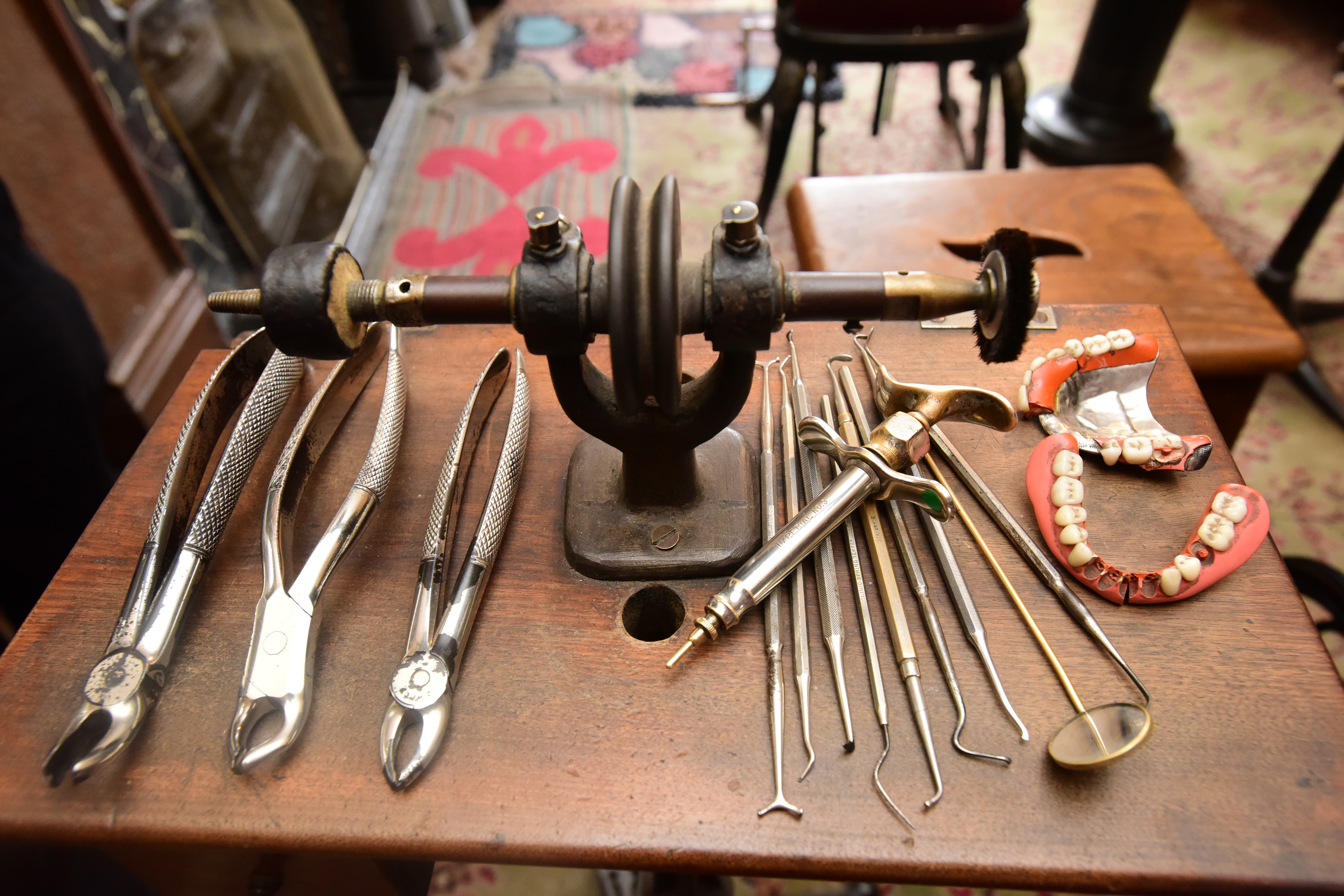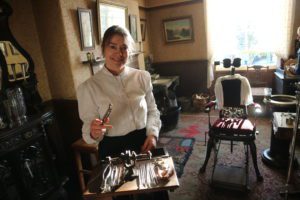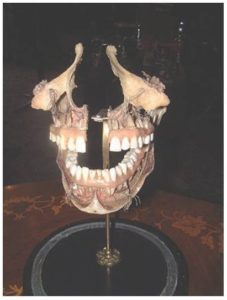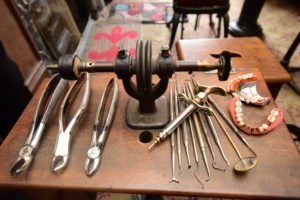
15 Oct The History of Dentistry: 1913 – Coal Fired Dentistry
What was dentistry like 100 years ago?
The answer to that question can be found at one of our favourite museums – Beamish.

The Dentist’s Surgery, Ravensworth Terrace, Beamish Museum of the North (photo courtesy of Beamish museum).
If you’ve never been, it is the ‘Open Air Museum of the North of England’, and features some fantastic exhibits in buildings from all over the North East that have been rescued and reconstructed.
One of the best is Ravensworth Terrace – a row of smart, middle-class homes. The terrace was originally built in Gateshead between 1830 and 1845 for well-to-do tradesmen and professionals.
One of the houses is that of a dentist and next-door is his surgery and a laboratory for his technician. The surgery is set in 1913 and is fully equipped with contemporary instruments and anaesthetics. And LOTS of false teeth.
“Dentist – a man who, putting metal in your mouth, pulls coins out of your pocket”
That quote by Ambrose Bierce in 1912 probably explains why the dentist’s house is beautifully furnished, with fashionable decorations and furniture.
His surgery too features solid, if slightly old-fashioned equipment, such as his treddle drill, the plush examination chair and the polished bottles of Ether and Laughing Gas (an extra-cost option to treatments).
But his practice is clearly doing well. And with fillings at 15 shillings (75p) each, and a full set of false teeth costing £7 (the equivalent of several months wages for many working men), so it should. In fact, at the time, fathers would often pay for their daughter to have all her teeth removed and replaced by dentures on her 21st birthday. This made her a more attractive marriage proposition, as her husband would never need to pay out for dental treatment. Happy birthday!
But to any modern dental practitioner, obsessed with cleanliness and sterilising everything in sight, the roaring coal fire and expensive carpet and curtains might come as a shock! At least the equipment was sterilised daily, so that’s okay …
What Beamish has to say about dentistry
We asked Rosie Nichols, Keeper of Social History at Beamish, about early 20th-century dentistry, and particularly the amazing exhibit at Beamish. “As luck would have it, I’ve been doing a wee bit of research lately on the late 19th-century and early 20th-century dentistry and home dental care,” says Rosie.

The Dental Technician’s laboratory, Ravensworth Terrace, Beamish Museum of the North (photo courtesy of Beamish museum)
One book she found is ‘Health, Beauty and the Toilet’ from 1886, by “a lady doctor”.
In it, the author says; “Nothing, in fact is worse for tooth, bone, hair, and complexion than our civilised and luxurious custom of daily swallowing hot food at all our meals… Americans are precisely the people who eat most hot dishes and who alternate them most ingeniously with icy cold drinks.”
According to Rosie, toothpastes were not available, but tooth powder preparations were available from chemist shops and were sometimes made at home.

Dental Specimen – late 19th century – human jaw, with teeth and nerves, in a glass dome. Purchased from Ash in 1909 for £3 – 6 – 0d. (Part of the Beamish Museum collection)
The ‘lady doctor’ advises against using a soap-based dentifrice as almost all of them “tend to make the teeth yellow” and she gives the following home recipe for tooth powder:
- Areca nut charcoal (5 ounces)
- Cuttlefish bone (2 ounces)
- Raw areca nuts (1 ounce) pounded together
Areca nut, also known as the betel nut, is still commonly chewed in South East Asia and is a well-known carcinogen, as well as being linked to type two diabetes and infertility – and it stains the teeth red!
Finally, our ‘lady doctor’ recommends the following liquid preparation for cleansing and preserving the teeth:
- Camphor (½ drachm)
- Lump sugar (½ ounce)
- Dry blanched almonds (½ ounce)
- Beat into a paste and then ½ pint water added and then the whole strained through linen
So, an ingredient in explosives mixed with the substance most likely to promote tooth decay, and the portion of a nut left after its most beneficial health properties have been stripped off. Toothpastes have come a long way in 100 years.
Qualifications
One of the exhibits that Rosie drew particular attention to was a notice prominently displayed in the surgery. “Our dentist’s qualification certificate is in pride of place on the wall; he trained at the dental hospital and school in Newcastle-upon-Tyne during the Winter session of 1911 to 1912. Would that be around 6 months, if we’re being generous?”

Early 20th-Century dental instruments (photo courtesy of Beamish museum)
While qualifications were much quicker to obtain than today, drills were treadle operated, and therefore much slower.
Drills like the one in the surgery would run at maybe a couple of hundred rpm. A few years later a dentist would be able to update with an electric drill running at 3,000 rpm. Today, the fastest air-turbine drills can run at up to 500,000 rpm.
More importantly than the drill speed, Rosie points out a major problem with the treadle drill. “The dentist could get tired if he’d done a fair number of fillings through the day, so you mightn’t want an afternoon appointment…”
Breath in and count backwards from 50
The issue about 1900’s dentistry that was most worrying for Rosie was the anaesthetic equipment in the Beamish surgery. “There is no gauge on our nitrous oxide and oxygen anaesthetic equipment, and no real way of knowing how the patient is doing whilst under the anaesthetic. The dentist would go by the approximate weight of the patient and their sex when deciding how much to administer! I think I’d be tempted by the cocaine injection instead…” But then, there’s a fair bit of guesswork in deciding the dose with that too.
Where can we find this paradise?

Visitors enjoying the Dentist Surgery, Ravensworth Terrace, Beamish Museum of the North (photo courtesy of Beamish museum)
Ravensworth Terrace is part of the 1913 Town area within the Beamish site. The museum also includes a Pit Village with a working steam winding engine, a Georgian manor house, a 1940’s farm and much more besides. You travel around the museum on a collection of restored electric trams, many of which were still working in the towns and cities of the North East after the second world war.
Beamish open-air museum is located at Beamish Museum; Regional Resource Centre; Beamish; County Durham; DH9 0RG. It is home to between 2 and 2.5 million items (including photographs), was founded in 1970, and is a registered charity.
For more information about Beamish, go to http://www.beamish.org.uk/, or for information about the latest innovations in modern dental software, go to https://pearldentalsoftware.com/ or call us on 0116 275 9995

